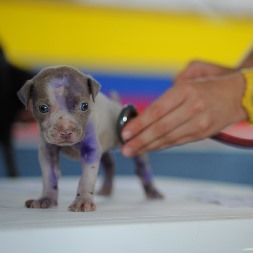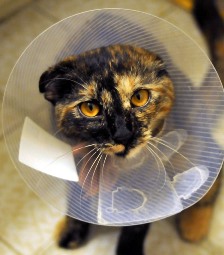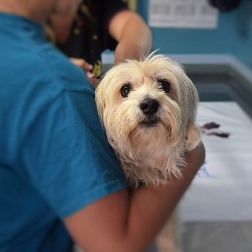How to Choose a Veterinary Technician School near Spring Gap Maryland
 Achieving your lifelong dream of working with and caring for pets by enrolling in a vet tech college near Spring Gap MD may initially feel like an overwhelming undertaking. After all, you have to find and enroll in a program that will furnish the proper training to ensure that you can succeed as a vet tech. But just how do you go about evaluating and comparing programs so that you can make the ideal selection? Many potential students begin their due diligence process by searching for schools that are near their homes. Once they have identified some area colleges, they determine which ones have the cheapest tuition and hone in on those. Although expense and location are important factors when evaluating vet technician programs, they are not the only critical ones when making your evaluations. Qualifiers such as internship programs and accreditation should be evaluated as well. The point is that there are questions you should be asking the vet tech schools you are looking at before you make an ultimate selection. We have provided several within this article to help get you started, but before we review them we’ll discuss the various duties of vet techs and the training options available.
Achieving your lifelong dream of working with and caring for pets by enrolling in a vet tech college near Spring Gap MD may initially feel like an overwhelming undertaking. After all, you have to find and enroll in a program that will furnish the proper training to ensure that you can succeed as a vet tech. But just how do you go about evaluating and comparing programs so that you can make the ideal selection? Many potential students begin their due diligence process by searching for schools that are near their homes. Once they have identified some area colleges, they determine which ones have the cheapest tuition and hone in on those. Although expense and location are important factors when evaluating vet technician programs, they are not the only critical ones when making your evaluations. Qualifiers such as internship programs and accreditation should be evaluated as well. The point is that there are questions you should be asking the vet tech schools you are looking at before you make an ultimate selection. We have provided several within this article to help get you started, but before we review them we’ll discuss the various duties of vet techs and the training options available.
The Role of a Vet Tech in Spring Gap MD
 One of the initial decisions that you will have to make is if you desire to train as a veterinary assistant, technologist or technician. Part of your decision may be based on the amount of time and money that you have to devote to your training, but the main factor will most likely be which specialization appeals to you the most. What techs and assistants share in common is that they both work under the immediate supervision of a licensed and practicing veterinarian. And while there are numerous functions that they can perform within the Spring Gap MD veterinary practice or hospital, they can’t prescribe drugs, diagnose health issues, or carry out surgical procedures. In those areas they can only furnish assistance to a licensed vet. There are technologists and technicians that work away from the standard vet practice, such as for zoos, animal shelters or law enforcement. Let’s take a look at the duties and education requirements for each position.
One of the initial decisions that you will have to make is if you desire to train as a veterinary assistant, technologist or technician. Part of your decision may be based on the amount of time and money that you have to devote to your training, but the main factor will most likely be which specialization appeals to you the most. What techs and assistants share in common is that they both work under the immediate supervision of a licensed and practicing veterinarian. And while there are numerous functions that they can perform within the Spring Gap MD veterinary practice or hospital, they can’t prescribe drugs, diagnose health issues, or carry out surgical procedures. In those areas they can only furnish assistance to a licensed vet. There are technologists and technicians that work away from the standard vet practice, such as for zoos, animal shelters or law enforcement. Let’s take a look at the duties and education requirements for each position.
- Vet Assistants in most instances will have undergone a formal training program, either as an intern or apprentice in a vet clinic or hospital, or by completing a certificate program at a community college or vocational school. As the name implies, their job function is to assist the vets and vet technicians in the completion of their duties. Usually they are not involved with more complicated activities, for example assisting with surgeries. A few of their normal functions may include working at the front desk, cleaning and preparing examination rooms and equipment, or controlling animals during examinations.
- Vet Technicians go through more advanced training compared with assistants and generally earn a two year Associate Degree, ideally from an American Veterinary Medical Association (AVMA) accredited program. They are in a sense the veterinarian counterparts of medical nurses, since their general job function is to assist veterinarians with diagnosing and treating animal patients. Where they differ from veterinary assistants is that they are engaged in more complex activities, such as assisting with surgical procedures or administering medication. All states currently mandate that vet techs pass a credentialing exam for either registration, certification or licensing.
- Vet Technologists are comparable to vet technicians and essentially perform the same job functions. They are required to obtain a Bachelor’s Degree in veterinary technology, which usually takes 4 years. Therefore the main distinction between a vet technician and a technologist is the technologist’s more advanced level of education. But with an advanced degree comes more work options, higher salaries and potential management positions. They are also required to pass a credentialing exam for either registration, certification or licensing.
Veterinary technicians and technologists may specialize in areas such as anesthesia, internal medicine or urgent care. Many may earn certification from the American Association for Laboratory Animal Science (AALAS) to work in Spring Gap MD laboratories or research facilities as well.
Veterinary Technician Online Schools Offered in Spring Gap
 An approach that might be a solution for those with a hectic lifestyle or who are working full time while attending vet college is to enroll in an online training program. Since the classes are made available through the internet, students can study on their own schedule wherever a computer is available. The educational program is taught using various methods, including slide shows, videos and live streaming webinars. And since many veterinary technician and technologist degrees require clinical training, that segment can usually be carried out as an internship or work study program at a local Spring Gap MD veterinarian practice or hospital. Distance learning, as it is also called, may in some instances lower the cost of your education. Tuition and secondary expenditures, for example for commuting and study materials, may be cheaper compared to more standard classroom programs. Just be sure that the online school that you select is accredited, either by the AVMA or another nationally recognized accrediting organization. With the online classes and the practical training, everything is furnished for a comprehensive education. So if you are disciplined enough to learn in this more self-reliant mode, an online vet tech school may be the ideal option for you.
An approach that might be a solution for those with a hectic lifestyle or who are working full time while attending vet college is to enroll in an online training program. Since the classes are made available through the internet, students can study on their own schedule wherever a computer is available. The educational program is taught using various methods, including slide shows, videos and live streaming webinars. And since many veterinary technician and technologist degrees require clinical training, that segment can usually be carried out as an internship or work study program at a local Spring Gap MD veterinarian practice or hospital. Distance learning, as it is also called, may in some instances lower the cost of your education. Tuition and secondary expenditures, for example for commuting and study materials, may be cheaper compared to more standard classroom programs. Just be sure that the online school that you select is accredited, either by the AVMA or another nationally recognized accrediting organization. With the online classes and the practical training, everything is furnished for a comprehensive education. So if you are disciplined enough to learn in this more self-reliant mode, an online vet tech school may be the ideal option for you.
What to Ask Spring Gap MD Vet Tech Schools
 At this point you probably have selected which veterinary credential that you wish to attain, and if you intend to study online or attend a college on campus. Since there are an abundance of veterinary community colleges, trade and vocational schools in the Spring Gap MD area and across the Country, you must ask some relevant questions in order to fine tune your list of alternatives. As we discussed in our opening, many prospective students start by prioritizing location and tuition expense. But we have already mentioned other significant qualifiers, which include accreditation and internship programs. And obviously you want to enroll in a program that offers the degree and specialty that you are interested in. These and other qualifications are addressed in the checklist of questions that you should ask the veterinary technician schools that you are considering.
At this point you probably have selected which veterinary credential that you wish to attain, and if you intend to study online or attend a college on campus. Since there are an abundance of veterinary community colleges, trade and vocational schools in the Spring Gap MD area and across the Country, you must ask some relevant questions in order to fine tune your list of alternatives. As we discussed in our opening, many prospective students start by prioritizing location and tuition expense. But we have already mentioned other significant qualifiers, which include accreditation and internship programs. And obviously you want to enroll in a program that offers the degree and specialty that you are interested in. These and other qualifications are addressed in the checklist of questions that you should ask the veterinary technician schools that you are considering.
Is the Veterinary School Accredited? It’s essential that you confirm that the vet tech program you select is accredited by a regional or national accrediting organization. As previously stated, one of the most highly respected is the American Veterinary Medical Association (AVMA). Vocational schools and colleges that are accredited by the AVMA have undergone a thorough review process that confirms you will obtain a superior education. Also, accreditation is essential if you are applying for a student loan or financial assistance, since many programs are not obtainable for non-accredited colleges. And finally, having a certificate or degree from an accredited college is often a requirement for employment for many Spring Gap MD area veterinarian clinics and hospitals.
What is the School’s Reputation? The veterinary college or trade school and program you select must have an exceptional reputation within the veterinary field. You can begin your due diligence by asking the schools you are reviewing for references from the employers in their job placement network. Other tips include looking on online school ranking websites and contacting the school’s accrediting agencies as well. You can ask the Maryland school licensing authority if there have been any complaints or infractions regarding your specific schools. As a final tip, get in touch with some Spring Gap MD vet clinics that you may want to work for after you go through your training. Find out what they think of your school selections. They might even suggest some programs not on your list.
Are Internships Offered? The best means to obtain clinical hands on training as a vet tech is to work in a medical environment. Ask if the programs you are looking at have internship programs set up with Spring Gap MD veterinarians, vet hospitals or practices. Almost all veterinary medicine programs mandate clinical training and many furnish it through internships. Not only will the experience be beneficial as far as the practical training, but an internship can also help build connections in the local veterinarian community and help in the search for a job after graduation.
Is there a Job Placement Program? Getting a job after graduating from a veterinary technician school may be difficult without the help of a job placement program. To start with, find out what the graduation rates are for the programs you are considering. A lower rate could suggest that the instructors were unqualified to teach the course of study or that a number of students were dissatisfied with the program and quit. Next, check that the colleges have a job placement program and find out what their placement rates are. A high placement rate may indicate that the program has an outstanding reputation within the Spring Gap MD veterinary community and has a considerable network of contacts for student placements. A lower rate might mean that the training is not well regarded by employers or that the job placement program is ineffective at placing students.
How Large are the Classes? If the classes are larger, you probably will get little or no one-on-one instruction from the teachers. Request from the Spring Gap MD colleges you are researching what their classroom student to teacher ratios are. You might also want to attend some classes (if practical) to monitor the interaction between students and instructors. Ask for feedback from students concerning the quality of instruction. Also, talk with the instructors and find out what their qualifications are as well as their methods of teaching.
Where is the College Located? Of course, we already talked about location, but there are a few more points to consider on the topic. If you are going to drive to your veterinary technician classes from your Spring Gap MD home, you have to make certain that the driving time fits into your schedule. For example, driving during the weekend to investigate the route won’t be the same as the commute during rush hour traffic, particularly if the school is located close by or within a large city. Also, if you do decide to enroll in a school in another state or even outside of your County of residence, there may be higher tuition costs especially for community and state colleges. On the other hand, taking classes online could be an option that will give you more flexibility and minimize the need for travel.
Do the Classes Fit Your Schedule? And last, it’s essential that you find out if the veterinary programs you are considering offer class times flexible enough to accommodate your schedule. For example, many students continue to work full time and can only attend classes on the weekends or at night near Spring Gap MD. Some might only be able to go to classes in the morning or in the afternoon. Make certain that the class times you require are offered before enrolling. Also, find out if you can make-up classes that you might miss as a result of illness, work or family emergencies. You may discover that an online college is the best solution to fit your veterinary education into your hectic life.
Enrolling in a Vet Tech School near Spring Gap MD?
If you have decided to attend a Veterinary Technician Program in the Spring Gap Maryland area, then you may find the following information about the location of your school campus interesting and informing.
Membrane distillation
Membrane distillation (MD) is a thermally driven separational program in which separation is enabled due to phase change. A hydrophobic membrane displays a barrier for the liquid phase, allowing the vapour phase (e.g. water vapour) to pass through the membrane's pores.[1] The driving force of the process is given by a partial vapour pressure difference commonly triggered by a temperature difference.[2]
Most processes that use a membrane to separate materials rely on static pressure difference as the driving force between the two bounding surfaces (e.g. reverse osmosis - RO), or a difference in concentration (dialysis), or an electric field (ED).[3]The selectivity of a membrane can be due to the relation of the pore size to the size of the substance being retained, or its diffusion coefficient, or its electrical polarity. However, membranes used for membrane distillation (MD) inhibit passage of liquid water while allowing permeability for free water molecules and thus, for water vapour.[1] These membranes are made of hydrophobic synthetic material (e.g. PTFE, PVDF or PP) and offer pores with a standard diameter between 0.1 and 0.5 µm. As water has strong dipole characteristics, whilst the membrane fabric is non-polar, the membrane material is not wetted by the liquid [4]. Even though the pores are considerably larger than the molecules, the liquid phase does not enter the pores because of the high water surface tension. A convex meniscus develops into the pore.[5] This effect is named capillary action. Amongst other factors, the depth of impression can depend on the external pressure load on the liquid. A dimension for the infiltration of the pores by the liquid is the contact angle Θ=180 – Θ'. As long as Θ > 90° and accordingly Θ' > 0° no wetting of the pores will take place. If the external pressure rises above the so-called liquid entry pressure, then Θ = 90°resulting in a bypass of the pore. The driving force which delivers the vapour through the membrane, in order to collect it on the permeate side as product water, is the partial water vapour pressure difference between the two bounding surfaces. This partial pressure difference is the result of a temperature difference between the two bounding surfaces. As can be seen in the image, the membrane is charged with a hot feed flow on one side and a cooled permeate flow on the other side. The temperature difference through the membrane, usually between 5 and 20 K, conveys a partial pressure difference which ensures that the vapour developing at the membrane surface follows the pressure drop, permeating through the pores and condensing on the cooler side.[6]
Many different membrane distillation techniques exist. The basic four techniques mainly differ by the arrangement of their distillate channel or the manner in which this channel is operated. The following technologies are most common:
Enroll in the Right Veterinary Technician College near Spring Gap MD
 Selecting the right vet tech school is a crucial first step to starting a rewarding career delivering care and treatment for animals. Students looking into veterinary technician colleges must make their selection based on a number of key factors. Veterinary technicians and technologists are employed in veterinary clinics and hospitals and animal shelters. They commonly take on administrative tasks and assist the veterinarian with the animal patients as needed. As we have covered, it’s very important that you select a veterinary medicine program that is both accredited and has an outstanding reputation within the profession. This goes for vet tech online schools as well. By asking the questions included in our checklist for assessing schools, you will be able to reduce your options so that you can make your final selection. And by selecting the best school, you can reach your goal of becoming a vet tech in Spring Gap MD.
Selecting the right vet tech school is a crucial first step to starting a rewarding career delivering care and treatment for animals. Students looking into veterinary technician colleges must make their selection based on a number of key factors. Veterinary technicians and technologists are employed in veterinary clinics and hospitals and animal shelters. They commonly take on administrative tasks and assist the veterinarian with the animal patients as needed. As we have covered, it’s very important that you select a veterinary medicine program that is both accredited and has an outstanding reputation within the profession. This goes for vet tech online schools as well. By asking the questions included in our checklist for assessing schools, you will be able to reduce your options so that you can make your final selection. And by selecting the best school, you can reach your goal of becoming a vet tech in Spring Gap MD.
Other Doggone Good Cities in Maryland
Business Results 1 - 10 of 9









